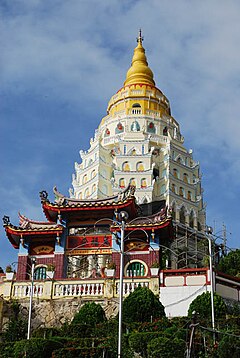
The construction of the temple began in 1890 and completed in 1905. It was inspired by Beow Lean, the chief monk of the Goddess of Mercy Temple at Pitt Street in 1887; he had served earlier in the Kushan Abbey in Fujian in China. The site chosen by Beow, a spiritual location in the hills of Ayer Itam, facing the sea, was named "White Crane Mountain". It was established as a branch of the Buddhist Vatican in Drum Mountain in Foochow in Hokkien province. Beow Lean was the first Abbot of the temple. The buildings of the temple complex were sponsored by five leading Chinese business people of Penang known as "Hakka tycoons". They were: Cheong Fatt Tze, his cousin Cahang Yu Nan, Chea Choon Seng, Tye Kee Yoon, and Chung Keng Kooi. Collection of funds for building the temple was also facilitated by dedicating the structures and artefacts in the name of the temple's benefactors.[ The main hall, which was completed first, housed a shrine to Guanyin, in a recessed area where many other female goddesses called the Queen of Heaven, the Goddess of the Earth, and Goddess of Childbirth are housed; which is said to represent, on a miniature scale, the island of Potalaka where there is a large shrine dedicated to Guanyin in the China Sea. People compared this shrine to the Amitabha Buddha's Western Paradise and started calling it the "Kek Lok Si" ("Jile Si"). There are also many other shrine chambers, which have stately statues, all gilded, of the Buddhas, Bodhisattvas, saintly Lohans, guardian spirits, and Heavenly (or Diamond) Kings of Pure Land Buddhism.
The consular representative of China in Penang reported the grandeur of the temple to the Qing Government. Following this, Emperor Guangxu invited Beow Lean to Peking in 1904 and bestowed on him, 70,000 volumes (7,000 is also mentioned in some references) of the "psalms and other sacred works of Buddhism" and also presented him edicts anointing him as "dignity of the Chief Priest of Penang" and also declaring "the Chinese temple at Air Itam as the head of all Chinese temples in Penang". On the Abbot's return to Penang, a royal procession, carrying the edict in a rattan chair and the scriptures in pony driven carts, was organised leading to the temple complex. Prominent Chinese dignitaries of Penang in their royal mandarin attire accompanied the Abbot in the procession.
In 1930, the seven storey main pagoda of the temple or the Pagoda of "Ban Po Thar", the Ten Thousand Buddhas, a 30 metres (98 ft) high structure, was completed. This pagoda combines a Chinese octagonal base with a middle tier of Thai design, and a Burmese crown (spiral dome); reflecting the temple's amalgam of both Mahayana and Theravada Buddhism. It represents syncretism of the ethnic and religious diversity in the country. There is a large statue of Buddha donated by King Bhumibol of Thailand diefied here. King Rama VI of Thailand laid the foundation for the pagoda and it is hence also named as Rama Pagoda.
In 2002, a 30.2-metre (99 ft) bronze statue of the Kuan Yin, the Goddess of Mercy, was completed and opened to the public. It replaced the previous white plaster Kuan Yin statue which was damaged due to a fire a few years earlier. The bronze statue is located on the hillside above the pagoda. The statue is complemented with a 60.9 metres (200 ft) three-tiered roof pavilion (with 16 columns made of bronze supporting the pavilion), which was completed in 2009.It is the tallest Kuan Yin statue in the world. One hundred statues of the goddess Kuan Yin, each of 2 metres (6 ft 7 in) height, are set around the main statue of the goddess. However, its height was restricted to avoid its shadow falling on the Penang State Mosque. This shrine also has other 10,000 statues of Buddha, apart from a statue of 12 Zodiac Animal Signs of the Chinese Calendar.
The temple complex has a large hydraulically operated bell, which tolls with a high pitch at frequent intervals. Wood and stone carvings are profusely seen in the temple. In front of each deity there is a cushion, impressive scrolls, and candles set in very attractive suspended lamps, and with a large number of priests in attendance.

No comments:
Post a Comment